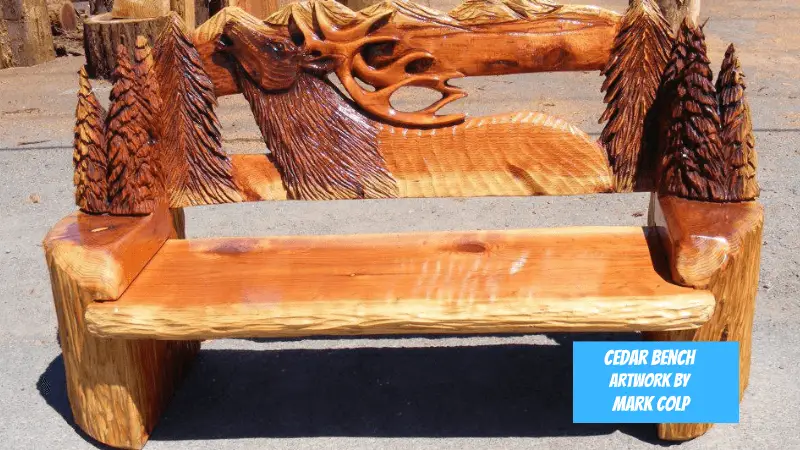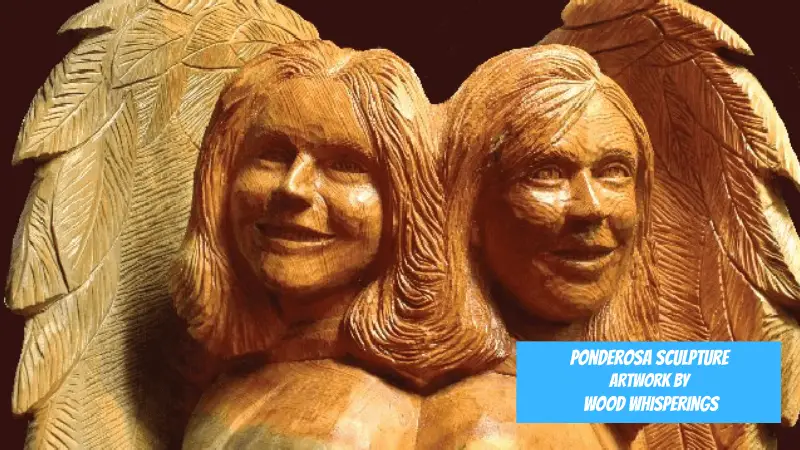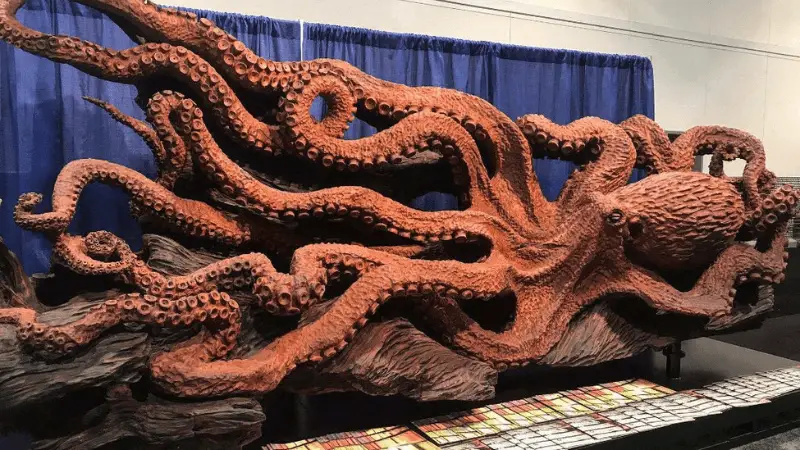The best wood to use when carving with a chainsaw depends on the project you’re trying to create, whether cutting small decorative pieces or more oversized functional items. Several species lend themselves well to chainsaw carving, some much better than others. Hence, it’s essential to understand the characteristics of each kind before you begin cutting away at your log.
In this guide, we’ll go over the basics of choosing the best wood for chainsaw carving and list out some of the top woods to use so you can start creating your next sculpture.
What to Look For in Wood
When carving wood, you should look for a few basic things: straight grain, intense color, and an even texture. You’ll also want to ensure that any branches or knots don’t protrude from the surface of your piece.
The chainsaw is highly unforgiving when working with knots; if you want detailed carvings, be wary of knots in your wood and try to avoid working with pieces that have them. If you’re looking for what to do with fallen trees and stumps on your property, chainsaw art is a great option—it helps clear space and gives way to beautiful finished products! Also, chainsaws offer more control than band saws or jigsaws can provide. If cutting patterns into wood interests you, consider taking up chainsaw art as a hobby.
Related articles
Choosing the best chainsaw for carving
how to sharpen a chainsaw.
Choosing the Best Logs
When choosing which logs will best suit your chainsaw carving project, there are a few things to consider.
- The first is choosing a log that has yet to decompose. A decomposed log can be problematic if you want to carve outdoors (where soil exposure will promote decomposition) or need access to a well-sealed garage or shed storage.
- Pay attention to whether you need something easy to cut through (like pine) or rigid (like Oak). But generally, the best wood for your chainsaw carving is softwood. This choice is made because softwood is easy to cut with a chainsaw since it has a weaker kickback and is less prone to cracking.
- Finally, avoid getting hung up on size; any log more than 6 inches across should be OK. If it feels right, it probably is.
The best wood for chainsaw carving
Chainsaw carving is a unique and intricate art form that requires a keen eye for detail and a deep understanding of the materials used. While no wood was explicitly created for this purpose, it is the responsibility of the carver to bring out the beauty and potential of the wood they have at their disposal.
As an experienced chainsaw carver, I have compiled a list of top wood choices to help you create stunning works of art. Please note, however, that this list is not meant to be exhaustive, and other woods may work well for your specific project.
White Pine
If you’re looking for a wood ideal for chainsaw carving, look no further than White Pine. This versatile wood is easy to carve and quick to work with – a crucial factor if you’re pursuing chainsaw carving as a profession.
One of the most significant advantages of White Pine is that it is suitable for both indoor and outdoor sculptures. White Pine is more decay-resistant than other woods, such as red pine and Basswood, making it a reliable choice for outdoor artwork. Additionally, it finishes nicely and can last a long time.

White Pine allows for intricate details to be carved into it, making it perfect for fine details that require woodcarving power tools. Whether you’re a beginner or a seasoned chainsaw carver, White Pine is a wood that can help you bring your artistic vision to life.
Another advantage of White Pine as a chainsaw carving wood is its lightweight nature. White Pine is considerably lighter than other woods, such as Oak, which are dense and heavy. This makes it easy to transport sculptures without putting too much strain on your body.
This feature of White Pine is especially beneficial for artists who create custom sculptures for clients. You can work with the wood at your workshop and then transport the finished sculpture to its final destination without needing forklifts or tractors. This saves you time and effort and makes the entire process more efficient and cost-effective.
Oak
Thanks to its dense and sturdy composition, Oak is a fantastic choice for chainsaw carving. Hardwoods like Oak are prized in carving circles for their precise ability to hold intricate details and textures.
In addition to their detailed carving capabilities, hardwoods are naturally weather-resistant and durable, making them ideal for outdoor sculptures and installations. There are only a handful of softwoods that can match the durability of hardwoods in outdoor settings.
Features that make Oak Best for chainsaw carving

Oak is a highly sought-after wood for chainsaw carving, and its wide availability and abundance make it an excellent choice for carvers of all levels. It’s worth noting, however, that freshly felled trees are best for carving, as older trees can become too dry and challenging to work with.
While Oak boasts numerous features that carvers dream of, such as strength and texture, cutting even with a chainsaw can be challenging. As a beginner, it may be best to start with a softer wood that is easier to work with, sacrificing some of the rich detail that Oak can offer.
It’s essential to remember that Oak requires regular chainsaw sharpening to work efficiently, and in extreme cases, special oak-cutting chainsaws may be necessary. However, with the right tools and techniques, Oak can be a highly rewarding and satisfying wood, producing stunning results that will impress viewers for years.
Redwood
Redwood is an excellent choice for chainsaw carving for several reasons. Firstly, it is a relatively soft wood, making it easier to carve with a chainsaw, allowing for smoother cuts and better control. It also has a straight and consistent grain, making it less likely to crack or split while being carved.
Redwood is also highly resistant to decay and rot, making it ideal for outdoor sculptures and carvings exposed to the elements. It is also naturally resistant to insects and pests, ensuring your carvings last long.
Furthermore, redwood has a unique and beautiful color, with warm reddish tones that give the carvings an appealing and eye-catching appearance. This natural color also allows for minimal finishing or staining, which can be a huge time saver for carvers.

Another advantage of using redwood for chainsaw carving is that it is the largest tree species in the world. This makes it an ideal choice if a giant sculpture out of wood is needed, as it provides the necessary size and scale for the project.
However, it’s important to note that redwood trees take a very long time to grow. Additionally, many of the remaining giant redwood trees are protected and cannot be cut down, which makes them even more valuable and rare.
Despite this, many redwood trees can be sustainably harvested and used for chainsaw carving. As a carver, it’s essential to choose responsibly sourced wood and to be mindful of the carving process’s impact on the environment. By doing so, we can continue to enjoy the beauty and benefits of redwood for years to come.
Cedar
If you’re looking for a softwood that can match the durability of hardwoods, cedar is an excellent option for chainsaw carving. Its weather-resistant qualities make it ideal for outdoor sculptures and furniture, such as benches.
Regarding chainsaw carving, cedar is relatively easy to work with, and you’ll likely find it pleasing to carve. However, be aware that splits and checks are common in prematurely harvested cedar lumber, so you must be mindful of these issues when selecting your materials.
Cedar produces natural oils that contribute to its weather-resistant qualities. However, to extend the lifespan of your outdoor carvings, adding a coat of poly or paint may be necessary to protect the wood from the elements.

In addition to its durability and weather-resistant qualities, cedar’s availability is another significant advantage when it comes to chainsaw carving. Unlike some rare or hard-to-find woods, cedar is widely available in many regions, making it an accessible option for carvers of all levels.
Access to a reliable source of high-quality cedar can make all the difference in creating stunning chainsaw carvings. With its desirable qualities and broad availability, cedar is an excellent choice for artists who want to produce beautiful, durable carvings that will stand the test of time.
Basswood
Due to its exceptional properties, Basswood is a highly sought-after wood for beginner and seasoned carvers. Despite being classified as a hardwood, it is surprisingly easy to work with and has a low likelihood of cracking or splitting while being worked on. Furthermore, it is an excellent canvas for paint, allowing artists to create unique and intricate works of art.

Basswood is a top choice among whittlers and hand carvers due to its exceptional properties, making it a highly sought-after wood. However, its popularity has made it quite pricey, especially when purchasing large pieces. Despite this, if you happen to come across some basswood lumber, it is worth trying, as you’ll quickly realize why it is considered the best wood for carving. Its ease of use, resistance to cracking and splitting, and excellent paint-holding properties make it a perfect choice for any carver.
Ponderosa
This wood is one of my personal favorites. Because ponderosa pine is so straight and has a more open grain than most other pines, it’s perfect for carving. Plus, it’s native to North America. Because of their hardiness, trees remain standing long after harvesting. A bonus? It’s available in just about every hardware store in the country!

More wood choices for Chainsaw Carving
- Black Walnut – A popular choice among chainsaw carvers, black walnut is a hardwood with a rich, dark color that can be polished to a high sheen.
- Hickory – Known for its strength and durability, hickory is a tough wood that can withstand heavy use. It has a distinctive grain pattern that can be challenging to carve, but it produces beautiful results.
- Cherry – A hardwood with a reddish-brown color, cherry is easy to carve and has a smooth texture. It also ages well, developing a deep, rich patina over time.
- Box Elder – A fast-growing maple species, box elder is a softer wood that is easy to carve. It has a distinctive white and pink grain pattern that can create interesting visual effects.
- Osage Orange – Also known as hedge apple or bodark, this wood is tough and dense, making it difficult to carve. However, it has a unique bright yellow color and can produce striking results when carved by an experienced hand.
- Butternut – A softer hardwood with a light color and subtle grain pattern, butternut is easy to carve and has a smooth texture. It is also lightweight, making it a good choice for larger projects.
- Sycamore – A hardwood with a light color and distinctive grain pattern, sycamore is easy to carve and has a smooth texture. It is also relatively lightweight, making it a good choice for larger projects.
- Birch – A hardwood with a light color and fine grain pattern, birch is easy to carve and has a smooth texture. It is also lightweight, making it a good choice for larger projects.
Factors to consider when choosing wood for chainsaw art include
- Availability: Consider the availability of the wood in your area, as well as the cost and effort involved in obtaining it.
- Ease of carving: Choose a wood that is easy to carve, especially if you are a professional who wants to produce carvings quickly. Consider the speed you can carve and how the wood responds to your tools.
- Durability: If your carving is displayed outdoors, choose a wood that can withstand the elements and won’t rot or decay quickly. Consider the wood’s natural resistance to insects and fungi.
- Finishing: Consider how well the wood takes finishes and what finishes you prefer. Some woods may require additional preparation or treatments before finishing.
Conclusions Choosing wood for chainsaw carving
When choosing wood for chainsaw carving, it’s important to remember that your choice of wood should not only be suitable for carving but it should also complement the design you have in mind. Depending on their texture, density, and color, some woods may be more appropriate for certain types of carvings than others. Choosing a wood that can withstand the stresses of chainsaw carving without splitting or cracking is essential.
If you’re new to chainsaw carving, we recommend checking out our beginner’s guide to chainsaw carving. It will provide useful tips and techniques to help you avoid common mistakes. You can create stunning chainsaw carvings that showcase your creativity and skill with practice and patience.

